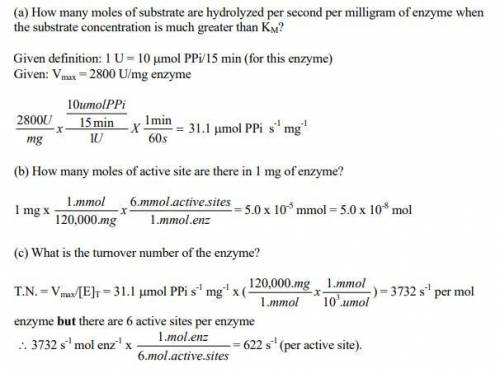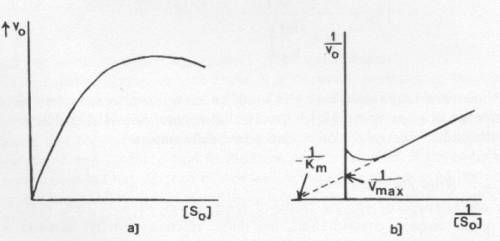
Biology, 18.12.2019 07:31 maymuu4life
The hydrolysis of pyrophosphate to orthophosphate is important in driving forward biosynthetic reactions, such as the synthesis of dna. this hydrolytic reaction is catalyzed in e. coli by a pyrophosphate that has a mass of 120 kd and consists of six identical subunits. for this enzyme, a unit of activity is defined as the amount of enzyme that hydrolyzes 10 umol of pyrophosphate in 15 min at 37 degrees c under standard assay conditions. the purified enzyme has a vmax of 2800 units per milligram of enzyme.
a) how many moles of the substrate is hydrolyzed per second per milligram of enzyme when the substrate concentration is much greater than km? (draw a velocity versus substrate
concentration graph to show your point)
b) how many moles of active sites is there in 1 mg of enzyme? assume that each subunit has
one active site.
c) what is the turnover number of the enzyme? (don't bother comparing it to other enzymes;
just show all your own, which equations you use, what numbers you use, where you get them
from, etc.)

Answers: 2


Another question on Biology

Biology, 22.06.2019 06:30
Photosynthesis uses co2 and cellular respiration produces co2. we call the point when the two processes are in balance--when there is no net production of co2--the compensation point. how might you limit one of the processes in order to achieve a compensation point?
Answers: 3

Biology, 22.06.2019 13:30
During the process of blank and molecules such as a glucose must use a protein channel to cross through a cell membrane
Answers: 1

Biology, 22.06.2019 14:00
Which of the following molecules can be broken down into simple sugars? a. nucleic acid b. protein c. lipid d. carbohydrate
Answers: 1

Biology, 22.06.2019 19:30
How does the fermentation of pyruvic acid in cells contribute to the formation of atp? a. it completes the oxidation of glucose to co2, creating atp. b. it generates lactic acid, which cycles back through the krebs cycle, producing 2 atp molecules. c. it converts fadh2 to phosphate, which bonds with adp. d. it produces 2 nad+ molecules, which cycle back to fuel the glycolysis reaction, allowing 2 atp molecules to be produced.
Answers: 1
You know the right answer?
The hydrolysis of pyrophosphate to orthophosphate is important in driving forward biosynthetic react...
Questions

Mathematics, 29.07.2019 02:30




Mathematics, 29.07.2019 02:30


English, 29.07.2019 02:30

Physics, 29.07.2019 02:30



Mathematics, 29.07.2019 02:30

Mathematics, 29.07.2019 02:30


English, 29.07.2019 02:30

English, 29.07.2019 02:30



English, 29.07.2019 02:30

Advanced Placement (AP), 29.07.2019 02:30

English, 29.07.2019 02:30





